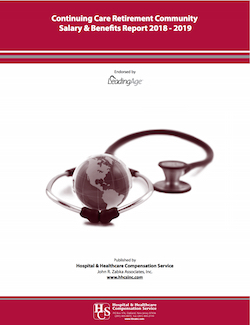
Pay for directors of assisted living/personal care who work in continuing care retirement communities, also known as life plan communities, averaged $73,938 in 2018, according to the “Continuing Care Retirement Community Salary & Benefits Report 2018-2019” issued by the Hospital & Healthcare Compensation Service in cooperation with LeadingAge.
Based on information submitted by communities that participated in the research in both 2017 and 2018, the average national salary for the position went from $71,323 in 2017 to $73,383 (national average range, $61,721 to $86,891) in 2018.
In these communities, directors of assisted living/personal care saw an average pay increase of 2.89% in 2018, the survey found. That rate is lower than 2017‘s 3.27% but higher than 2016‘s 2.29%, according to previous reports.
More than half (56.11%) of the 520 CCRCs participating in the research this year reported offering assisted living and personal care.
The national average salary for directors of assisted living/personal care in communities with up to 299 units/beds was $69,635, and it was $77,307 in communities with 300 or more units/beds.
The national average salary for directors of assisted living/personal care in operators with revenues up to $14.99 million was $68,732, and it was $76399 in operators with $15 million or more in revenues.
The region offering the highest pay for assisted living/personal care directors at CCRCs includes Alaska, California, Hawaii, Oregon and Washington. There, salaries average $67,341 to $95,375, according to the report.
The region including Iowa, Kansas, Minnesota, Missouri, Nebraska, North Dakota and South Dakota had the lowest midpoints and lowest average maximums for its pay ranges, at $68,710 and 77,759, respectively. The region including Illinois, Indiana, Michigan, Ohio and Wisconsin, however, had the lowest average minimum, at $57,263.
Data were sufficient and available for five of the nine regions into which the report divides the country.
The 21st annual study provides compensation data on more than 79,000 employees, covering 46 management and 53 nonmanagement positions. Findings are reported according to revenue size, total unit size, geographic region, state and core-based statistical areas. The report also includes data on 18 types of fringe benefits, turnover rates by department and projected salary increases by department.
Eighty-two percent of participating communities were not-for-profit (45% of which reported being religiously affiliated), and 18% were for-profit.
The report is available online for $350, or $275 for LeadingAge members.



